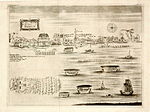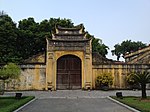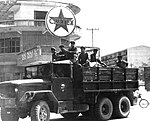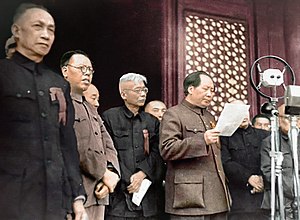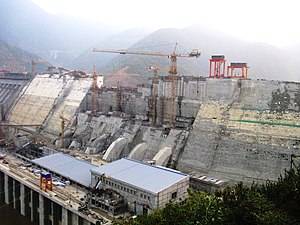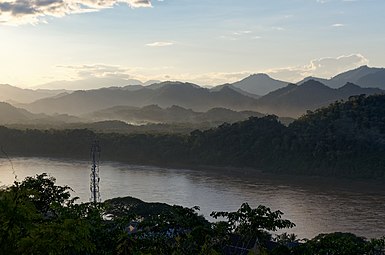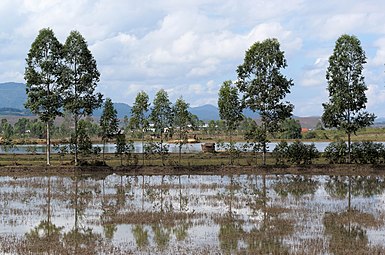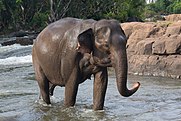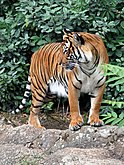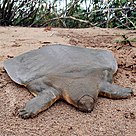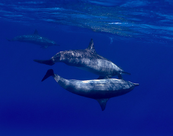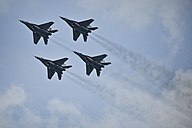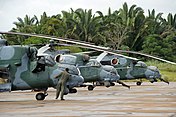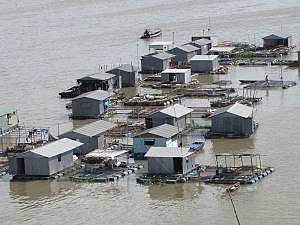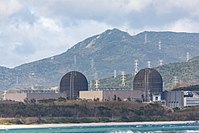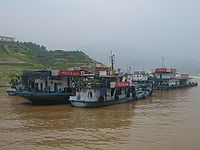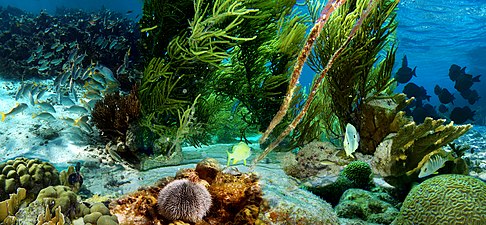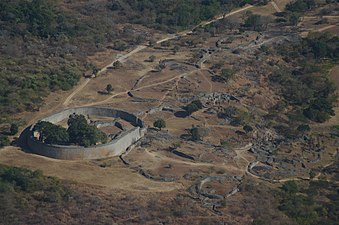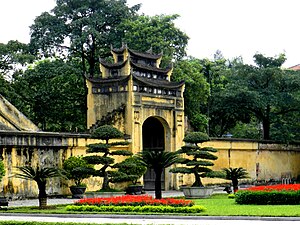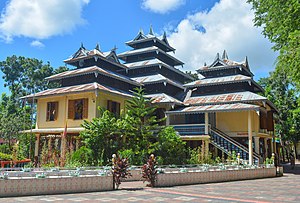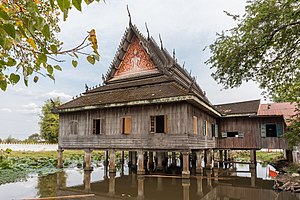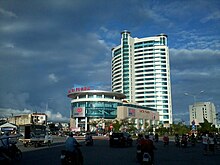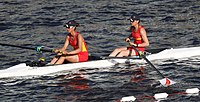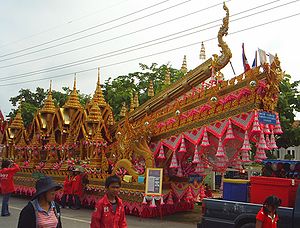Lavana
This article is incomplete because it is pending further input from participants, or it is a work-in-progress by one author. Please comment on this article's talk page to share your input, comments and questions. Note: To contribute to this article, you may need to seek help from the author(s) of this page. |
People's Republic of Lavana ສາທາລະນະລັດປະຊາຊົນລັດ ລະຫວ່າແ Javunganiboga Bügd Nairamdakh Lavana Uls Lavana Xalıq Respwblïkası République Populaire de Lavana | |
|---|---|
| Motto: "ຈາກແມ່ນ້ ຳ ທີ່ຍິ່ງໃຫຍ່" "From the Mighty Rivers" | |
| Anthem: ດວງຕາເວັນແດງຂອງລັດ ລະຫວ່າແ (The Red Sun of Lavana) | |
 Location of Lavana on Kylaris in dark green | |
| Capital and largest city | Pers |
| Recognised national languages | Kachai, Ziba, Ukilen, Veneran, Gaullican |
| Ethnic groups | Kachai 61% Others 5% |
| Religion | Badi 52% Irreligion 30% |
| Demonym(s) | Lavanan |
| Government | Council republic |
• Premier | Laina Keomany |
• Vice-Premier | Trang Dong |
| Legislature | Congress of Lavana |
| Establishment | |
• Formation of the Kingdom of Lavana | 1876 |
• Establishment of the Republic of Lavana | 1951 |
• Establishment of the People's Republic of Lavana | 1960 |
| Area | |
• Total | 713,879 km2 (275,630 sq mi) |
| Population | |
• 2020 census | |
• Density | 121.65/km2 (315.1/sq mi) |
| GDP (PPP) | 2020 estimate |
• Total | |
• Per capita | |
| GDP (nominal) | 2020 estimate |
• Total | |
• Per capita | |
| HDI (2020) | 0.806 very high |
| Currency | Lavanan Dunan (LZ) |
| Date format | dd-mm-yyyy |
| Driving side | right |
| Internet TLD | .lv |
Lavana (Kachai:ລະຫວ່າແ, Lavanga; Ziban Javunga ) officially the People's Republic of Lavana (Kachai:ສາທາລະນະລັດປະຊາຊົນລັດ ລະຫວ່າແ, Sathalanalad Pasasonlad Lavanga; Ziban Javunganiboga) is a sovereign state in Southeastern Coius. It borders Dezevau to the north, the Brown Sea to the east, and tbd. With a total area of 713,879 km2, and population of 86.8 million people, its one of the largest countries by population in the world. It's capital and largest city is Pers, its also the country's economic, political and cultural centre. It stands besides the city of Thy Lucc which was the historical capital of empires in Lavana.
Inhabited since antiquity, agriculture and language was brought by Ziban migrants and traders who expanded on Lavana utilizing the countries wide river system to establish centers of trade and the establishment of the first city states in the inland regions, while a distinct . The city states would eventually band together in various federations and empires usually centered on the centrally located city of Thy Lucc from which the Sasuanan empire began emanating power and influence from the 4th century BCE onwards. The Sasuanan Empire established the tradition of a centrally located aristocracy and center of power centralized on a Sao comparable to an emperor, such traditions would continue for several centuries. The Kachais originally from the areas surrounding modern day Kuthina would begin their migration around the 8th century CE with many finding their ways as mercenaries towards the warring factions following the collapse of the Nukhao empire, Kachai influence would reach its highest point when aristocrats and military leaders of Kachai descent would establish a Kachai king during the reign of the Damrog Empire in the 11th century. Weakening Damrog Empire influence and power would result in the rise the Aguda Empire in southern Dezevau from former Damrog holdings which would grow onto control most of Dezevau and Lavana.
The Aguda Empire would reach its apex in XXXX when it held vast influence and land throughout Coius, the arrival of Eucleans mainly Gaullicans into the region began a slow decline as foreign influences weakened its internal structure at points the Agudan Empire existing on paper while entities such as the Saint Bermude's Company from Gaullica managing the lands of the former Agudans as colonial holdings. The Kingdom of Lavana would be established in the aftermath of the dissolution of the Agudan Empire, the Kingdom of Lavana would remain a puppet of Gaullican and later Estmerish colonial administrators. Growing international pressure and the ranging war for independence would result in Lavanan independence 1951, the Republic of Lavana would suffer from growing tensions between democratic and socialist factions in its government resulting in a 1957 military coup and the start of the Lavanan Civil war, which would rage until 1960 when Socialist forces would declare the People's Republic.
Lavana would integrate into the international socialist movements alongside it's two close Socialist neighbors in Dezevau and South Kabu founding the Brown Sea Community in . In 1981 the country would be involved in an insurgency against steppe ethnic groups, which would only end in 1989. The country today is a developing economy, with close ties to it's Northern neighbor and other socialist states, the government has followed the trend of liberalization and opening up which followed after decline of Socialist countries in the 1980's and 90's. It has been a member of the AIS since it's inception in 1980.
Etymology
The term originates from the Kachai combination of between lavang (ລະຫວ່າງ) and river aemn am(ແມ່ນ້ ຳ), Lavana means "between rivers" in the native Kachai language. The term was popularized during the era of the Aguda Empire as the territories inhabited by the Kachais were marked as being between the Siadng and Kalani rivers. Do to the constant interaction of the population with rivers and other waterbodies the term was quickly picked up by Euclean traders and used to refer specifically to the area in modern Lavana, and other areas in the Agudan empire where Ziba was not the main language. Upon separation from what would later become Dezevau following the collapse of the Agudan empire in 1866, the name Lavana was picked to represent the new Kingdom of Lavana established by colonial administrators.
History
Pre-history
| Lavana Timeline of Significant Eras | ||||||||||||||||||||||||||||
|---|---|---|---|---|---|---|---|---|---|---|---|---|---|---|---|---|---|---|---|---|---|---|---|---|---|---|---|---|
|
||||||||||||||||||||||||||||
Lavanan pre-history can trace itself to migrating Hunter gatherers which hunted various animals in the fertile regions of Lavana, where ample grazing areas for animals was present. Archaelogical evidence shows use of early-prehistoric bone tools almost 1 million years ago, and other discoveries such as fossilized teeth to 125,000–80,000 years ago. The discovery of agriculture can trace its origins to Dezevau, rice was the primary crop grown in the numerous fertile rivers and remains to this day its most important. The Duh-Hoc civilization is the earliest settled society in Lavana with a written record, the Duh-Hoc society is believed to have been first established in the 9th century B.C.E. along the banks of the Siadng river, this civilization utilized the vast waterways for communication and trade. They're most well known for their jars, which have been suspected to serve a ceremonial purpose, many jars have been found holding possessions along with the remains of individuals, which could show early funerary rites. To ensure the free and safe passage of trade and goods, fortified settlements were constructed alongside rivers to defend them, along with the collection of taxes in the form of rice. Early texts describe this system of taxation.
The Duh-Hoc civilisation experienced an eventual fragmentation as it spread throughout the land, eventually numerous city-states would be established around the 8th-6th centuries BCE, a trend that would continue through the countries history. The Sao, was a titled designated to the leader of a city state, and was commonly associated with someone of minimal control outside of city walls, the term grew in significance throughout the ages, and its meaning was replaced and increased. During this time as well, the !Austronesian migrations, which date from the 8th through 4th century BCE, originated from the South of Coius around Kuthina. They settled primarily in the coasts of the country and established well connected wealthy coastal cities, which usually demanded tribute from upstream cities to access their vast rudimentary trading network. War was common for this early societies, and numerous conflicts were fought for control of farmland, access to bodies of water, and trading routes. Cultural differences were observed in the early Ziban society in Lavana, which unlike modern belief remained a vastly diverse group, only united in a similar writing system. During this time many animist beliefs were held throughout the land, many texts survive telling of rituals and ceremonies in early Lavana, construction of temples was also commonplace.
Sasuanan empire (3rd Century B.C.E-1st Century C.E.)
The city of Thy Lucc at the junction between the Kung and Siphadon rivers had by the early 4th century B.C.E., become among the most powerful city-states in inland Lavana, its vast power and influence were crucial in the empires growing control of the Kung river, Lavana's major transportation route. Aggressive military campaigns by Sasuana Lin the Sao of Thy Lucc and vast irrigation projects on the 3rd century expanded Sasuana's territory which by the time of his death in 316 BCE had carved a sizeable territory administered by Thy Lucc and a large federation of city states cemented the status of the Sasuanan Empire. The title of Sao taken as protector of Thy Lucc came to represent the position of power over the lands of Lavana. Over the coming years and successful Sao reigns growing Sasuanan influence would culminate in near total control of the Kung river for the empire which utilized this strength to acquire great concessions from the coastal cities which had tried to resist Sasuanan power but its vast population and control of the centre of the country made it increasingly difficult to combat the Sasuanans.
The Sasuanans would reach the peak of their power in 99 BCE with the reign of Sao Bis Lap which successfully reigned in much of the coastal city states under Sasuanan control or alliance. During his reign the construction of temples and shrines towards the 20 sisters from Lavanan mythology increased, alongside the first attempt at codifying a standard Ziban language although this attempts were soon ended following the death of Bis Lap in 61 BCE. The Lap dynasty he established would rule the Sasuanan empire until its demise. Following Bis Lap's death power struggles inside the empire began to weaken its central foundations as allied city states primarily coastal city states demanded further liberties and freedoms in their governance. During this time Steppe raiders became a growing threat, with Sasuanan gold used to bribe them from invading or raiding the empire, droughts and general loss of agricultural output cause a great strain on the Sasuanan economy and the imperial treasury. Its inability to provide food nor money for the empire would result large scale rebellion on the 5th CE, during this time Sao Nan Laps reforms regarding Sasuanan administration and the army provided the necessary funds and resources to utilize steppe armies, one of this armies led by Lao Va was crucial in retaking the city of Kila in modern day Laitaka, ending the rebellion in 10 CE.
The period of relative stability brought on following the civil war was quickly destroyed when Nan Lap died in 17 CE, leading to a 3 year civil war between his 5 sons as no clear successor could be found. In the end Nan laps youngest son Liz Lap would be crowned Sao in 20 CE using the help provided by Lao Va which had married Liz Lap and one of his daughters. Fearing that a foreigner now controlled the Sao, rebellion sparked again, Lao Va fought a grueling campaign the next decade against rebellion and city-states in southern Dezevau expanding the Sasuanan empire in that region. The death of Liz Nap in 33 CE, would result in the establishment of the Lina Dynasty which would rule the country under the protection of the steppe raiders. Infighting among the Sao and his steppe handlers would result in internal instability, finally culminating in general anarchy and conflict between 50 CE and 97 CE, when Pae Halin was crowned as Sao, establishing the Nukhao empire with the Halin dynasty at its head.
Nukhao and Alavari empires (1st Century C.E.-8th Century C.E.)
Pae Nukhao had inherited the fractured and corrupted inner bureaucracy of the Sasuanans which had been greatly neglected during the period of instability. Wide and vast reforms on the inner workings of the state were began by Pae, this reforms sought to reduce the extent of Imperial bureaucracy which had ballooned greatly and been reduced in efficiency. Such reforms were key in returning stability to the state and its citizenry. The Nukhao empire had by the death of Pae in 120 returned to the economical prosperity prior to the crisis during Nan Laps reign. Pae's son Kale I Halin began a series of military incursions into Dezevau re establishing Thy Luccian control over the coastal cities of the Bay of Lights, Kale I had during his time in Dezevau become a follower of Badi, at the time although religious freedom existed under the state to ensure harmony between the different beliefs in the nation, no Sao had deviated from following an outside belief. Kale I established Badi schools and temples and is credited as introducing the belief into Lavana where today its the largest religion in the country.
Nukhao rulers following the steps of Kale I further converted into Badi, and aided in the development of the region north of the Siadng river, such developments included the creation of roadways between cities and establishing garrisons to ensure free passage for traders and merchants. Such developments incorporated the region into the empire. The Nukhao turned their attention towards the steppe, as Nukhao armies entered into the steppe in the 3rd century, they increasingly sought to establish tributary states to serve as buffer states and ensure the safe passage of trade between Shangea and Lavana rather than expand the borders of the empire. Kale III sought to expand Nukhao influence by advancing along the Teyvada river into the highlands of modern Zomia, where he ordered the construction of Badi temples to "civilize" the highlanders in the region through the proselytizing of Badi and the teaching of Ziban script. Kales effort were successful in establishing tributary states which protected the vital inland trading routes of the region, and allowed Badi to greatly expand across Coius.
In 350 CE, Sao Zankin Halin the reformer launched a coup against his uncle Sao Ilhan Halin which had come to be seen as a weak and inefficient leader by the nobility. Zankin is celebrated for his vast reforms among which include the codification of Nukhao and earlier Sasuanan law into a single code, called Jaibodemhe (the Code of Zankin). The code represented the legal framework of the state in a single language essentially enforcing a national language, Ziba. The standardisation of the use of Ziba allowed for smoother bureaucracy and easier trade, the reign of Zankin was marked as among the most prosperous in Nukhao history, the Gogajedaiza (Great Water Temple) was constructed during his reign.
Nukhao attempts at further conquest into Dezevau were met with strong resistance, Nukhao campaigns into Dezevau proved highly costly and by 400 CE the Nukhao empire reached its largest territorial extent. A period of instability between 390 and 440 followed the empire, plague outbreaks hit the Nukhao empire several times between 410 and 450 some estimate that up to a fifth of Nukhao's population died from plague outbursts, once such outbreak in Pers decimated the cities population and greatly reduced the size of the royal court. Succession crisis and civil wars plagued the empire for several years decimating the empires economy and its bureaucracy, the periphery of the empire began to break away from the empire in a period which would repeat in Lavanan history and latter Agudan history, by 460 the Alavina sisters would be crowned as Sao's following a prolonged civil war and officially proclaim the end of the Nukhao Empire, establishing the Alavari Empire and the Alavina dynasty. Both sisters struggled in establishing control over the warring factions of the empire, and the Second empire suffered during the rest of its existence instability and a powerful land owning nobility which usually challenged the Sao's authority.
The Alavari empire began a process of decentralization in its state and bureaucratic structure starting in the early 6th century, this period saw a rise in regionalism and subversion of the Sao, which became a figure head while local warlords ruled over the country. Although the decentralization of the state saw the Sao lose its power, it maintained relative peace in the country for the next century as regional warlords battled each other for control in regional wars rather than the large scale wars that had plagued the empire at other times.
By the 8th century some nobles held near complete independence from the Sao with strong armies and populations to support them and their endeavours, with the Sao serving exclusively as a figurehead. Sao Goabodaga Alavina IV would die in 763 without a heir, rather than elect a member of the royal family to the position, a local noble crowned himself as Sao ending 300 years of the Alavina Dynasty. Sao Bereste Nala sought to utilize his strong position to centralize the empire, to increase his own power, such a move was not welcomed by other powerful nobles who looked at establishing strong independent kingdoms free from the control of Thy Lucc for the first time in 11 centuries. Sao Bereste was unable to hold control over the warlords and nobility and the Alavari Empire stopped functioning as a state, the position of Sao also lost its prestige and inherent power, with every noble crowning himself as a Sao and the dynastical tradition broken. Historians usually only classify a Sao if they held the city of Thy Lucc.
Warring states period (763-875)
The Warring States period would last from 763 to 875. The period would see a shifting change in alliances, hegemony, and influence, as regional warlords and foreign entities increasingly fought for control of the region.
Classical Kungian Period (7th Century-12th Century)
Late Kungian Period (12th Century-14th Century)
_________ Damrog -Use epic !Chinese Examination B)
The Aguda Empire
Colonial Period
Great War
Estmerish mandate
Following the defeat of Gaullica, Lavana fell under the control of Estmere, as Lavanan soldiers returned from overseas they found themselves serving under their previous enemies. The Sao was allowed to continue on his position and welcomed the arrival of Estmerish authorities in the hopes of calming civil strife in the country, the Sao found himself with an undermanned and understaffed Estmerish contingent unable to manage both Dezevau and Lavana, the Sao royal guard was expanded to make up for Estmerish undermanned forces. Following the independence of Dezevau Estmerish forces were brought in to reinforce and train royalist forces in the face of growing threat from the Coalition for a Free Lavanan, it was estimated that 13% of the countryside was under CFL control, a Royalist offensive in the summer of 1939 found little success in reconquering LDL territory, the CFL retaliated by murdering Estmerish High Commissioner to the Sao Ivan Lloyd in 1940 prompting large Royalist movements into the countryside which found little success.
CFL activities were at the time greatly concentrated in the Ziba speaking part of the country as support from Dezevau was acquired, but the growing influence of Dezevau and its socialist government resulted in greater power and influence for the Socialist forces which found themselves benefited directly by Dezevauni support, repeated Sao attempts at targeting Ziba speaking communities caused outcry by socialist states. Estemerish economic and military aid towards the Sao increased as fear of further international aid might cause a succession of revolutions to explode in Coius, such efforts were cut abruptly short with the start of the Solarian War which saw Estmerish forces relocated from Lavana to other fronts to aid the war effort. Droughts between 1942 and 1945 impacted the south east of the country resulting in famine like conditions for many poor farmers, such situations led to a large scale civilian migration towards the cities, the Sao was unable to quell the growing unrest and several CFL attacks on cities most primarily Edrona which was under CFL control for an entire month in 1945 until Royalist and Estmerish forces which had been further reduced at the end of the Solarian war retook the city, to heavy casualties on the CFL side which lacked the aerial and artillery support available to the Royalists.
Sao Thy Atith would die on June, 1950 his son the 16th year old Lin Atith was next in succession but fears regarding the boys mother which had been imprisoned for fears of being a CFL sympathizer just a few months prior, caused Estmerish authorities to install Thy's uncle Oke instead causing a power struggle inside the royal family. Fighting broke out between Lin and Oke loyal forces giving the opportunity for the CFL to retake lost territory, although fighting was over by July with a clear victory for Oke. On October 1950 Lavanan exile and leader of the Lavanan Section of the Workers International Saravan Khouph gave a speech decrying Estmerish colonization and the brutal rulership of the Sao, pressure increased for Estmere and other Euclean powers to decolonize. A CFL attack on Pers on December 1950 and a general offensive the month after saw large sections of the Royalist army some loyal to the former Lin defect with some joining the CFL. Oke agreed to a national referendum regarding the establishment of a republic for the 19th of August along with a general election the month after shall it pass. Estmerish forces under international pressure agreed to pull all military forces from Lavana regardless of outcome by December 31st 1952. A general victory for a republic on the national referendum finalized the Kingdom of Lavana, and the position of Sao. Makaio Sayasone was elected to the position of Prime Minister after the CFL won 70% of the vote a month later.
Republic of Lavana
The rapid chain of events tested the resolve of the CFL, the bureaucracy of the Sao upon news of the end of the Kingdom and the start of restructuring of the bureaucracy many left for Euclea or retired creating a strain on the administration of the republic which could not be as easily managed as thought. The Royal Lavanan Armed Forces found itself in a similar predicament with the ruling CFL holding now control over the enforcers of the Sao's and colonial will, attempts to create new armed forces found little success as the RLA command structure refused to step down, a compromise was reached with the RLA renaming itself and minor reforms but maintaining the same corrupt structure that had plagued its efficiency during the revolution. The CFL had also struggled with internal infighting primarily between the Workers International and the greater coalition including other socialist parties. The return of Saravan Khouph had reinvigorated the Workers International which had taken a secondary role to the Lavanan Socialist Party during the revolution, the CFL struggled to reign in its Socialist parties which began to increasingly align itself with the Workers International or the LSP. With the retreat of Estmerish forces by the end of 1952, violence spread throughout Lavana as government institutions which had functioned for decades under the corruption of the Sao could no longer operate efficiently. The inability of Makaio in maintaining stability and declaring an official constitution caused the Workers International under Khouph to exit the CFL in April 1953, establishing itself as part of the opposition which had grown with dissastified parties. By October 1953 the CFL which had come to envelope close to 50 different parties at its height now maintained only 5 parties under the Democratic Front the largest single party in Parliament.
Lavana entered a deep recession in 1955 as inner fighting inside the parliament prevented necessary monetary reforms to the nations broken economical model following the exit of the Sao. Facing health problems Makaio would retire that years October, causing a leadership crisis and another election by December. The Workers International acquired a large victory in the elections cementing itself as the 2nd largest party in parliament, causing an uproar in conservative sectors of the Lavanan society. Violence between socialists and conservative elements in Lavana would break out following the election, government inefficiency under the leadership of Sin Duon left over by his predecessors resulted in large street brawls and general violence throughout the country extending onto March 1956. The Workers International had by the end of the conflict united all Leftist parties under its wing along with establishing the National Defence Commission, which operated as paramilitary forces of the party, usually deployed to the countryside to stop banditry which had greatly expanded following the revolution.
Further mismanagement during the abnormal year of flooding in 1956, would result in 15,000 deaths. The government held little to no control outside of the cities as the Workers International took over the job of policing and administration in rural areas, in one such instance a party employee filed taxes for over 5,000 citizens in rural villages as fines would be raised if the taxes were not paid but access to basic services such as water and electricity were provided separately by the Workers International. Government inability and infighting had allowed such dual government to exist, General Oke Syrypanha general commander of the army had under the instructions of Pers attempted to reign in the Workers International and their paramilitary forces but such attempts were met with brutal skirmishes, after a brutal skirmish had left 15 soldiers dead in the Gezije Range on the 9th of March 1956. Sin Duon expulsed the Workers International from parliament on the 13th of March as response to the violence between Socialist paramilitaries and government forces, Duon had intended on arresting the WI leadership in the hopes that Socialist paramilitaries would not react violently if their leadership was arrested. The attempt failed as the announcement was leaked and WI leaders abandoned the Congress, socialist leaders remained in hiding for several months until they could escape Pers.
Civil War
News from Pers were misinformed and numerous army units were not informed of what had occurred, and some forces thought a coup had taken place. The news quickly mobilized the socialist forces into action, government forces had differing orders and were unable to prevent major socialist assaults, nor retake socialist controlled lands for several days. Socialist forces launched major offensives into Yars, Liucpa, and Pers, socialist attacks on Pers had successfully allowed large amounts of WI operatives to exit the capital including Saravan Khouph. Government forces were able to stop socialist forces from Liucpa and a deadly series of urban battles would follow for control of the city for the rest of the war, Yars was lightly defended and socialist forces were quick to take and secure the city, which was quickly proclaimed as the temporary capital of the Republic of Lavana as Saravan announced that the congress in Pers was illegitimate. The socialist forces had secured Yars and most of the Ziba speaking parts of the country, Dezevau were quick to provide aid to the socialist forces.
Government forces were caught off guard by the sudden start of the war, and numerous army units deserted rather than face the socialist forces. Dezevau which had been in discussion with Khouph assured their support, Dezevau began the process of moving former Lavanan socialists back to Lavana.
Modern times

With the fall Socialist governments and a reduction on restrictions and isolations, Lavana found itself increasingly liberalizing alongside its neighbors. The liberalization of diplomatic relations with countries such as Estmere and Gaullica caused large scale riots in Pers on March 1992, with large scale opposition to closer ties with the Euclean states, as a result of the large scale public reaction. Lavana maintains only minimal relations with its formal colonizers.
The need of further electricity for Lavana, and further expanding it's energy diversity the Lavanan Congress approved in 2004 a wide variety of projects including the construction of along with numerous other projects including 4 nuclear reactors, and 2 wind farms but most prominently a dam in the Lav San river in the north of the country, which had been marked for possible hydroelectric potential in a study in 1994. The dam began construction in 2005, with help from Dezevau, the dam finished building in 2014, becoming the largest dam in Southeast Coius.
Geography
Lavana is located between latitudes 7° and 17°S, and longitudes 59° and 83°W in the eastern portion of Coius. It borders Dezevau to the north, the Brown Sea to the east of the country, X to the south, and X to the west of the country. Lavanas total area is 713,879 km2 (275,630 sq mi), making it a relatively large country in the world, Lavana has a long coastline with the Brown sea holding sovereignty over several islands but most of this are small islands off the coast.
Lavanas borders mostly stem historical precedent which defined the nation of the Kachais from the Siadng river in the north and the Kalani river to the south, with most of its western border a result of colonial rule which defined the border without taking into account the ethnic makeup of the area. Its Northern border was the subject of much controversy during the partition of the Aguda Empire and the latter independence of Lavana and Dezevau, both nations have since defined the border.
Lavana is a relatively flat country with mountainous and hilly regions to the north and west of the country, the Gezije range defines most of the northwest of the country where its mountainous territory spills between both Lavana and Dezevau. The Gezije ranges gives way to hilly regions to the west of the country called the Nayzabeler which eventually give way to the steppe reminiscent of the Great Steppe, powerful rivers traverse the southwest corner of the country eventually drain into the Ikaika lake, the Kung and Phankham rivers originate west of the Nayzabelers. To the east of the Gezije the Zedenge valley along the Siadng river gives way near the coast to remnants of Bouvai Massif stretching from Dezevau. The rest of the country is relatively flat with vast rivers the most prominent of which is the Kung river transversing the land. The Kung rivers water basin covers large parts of the country and has served the role of the central artery to civilization in Lavana since ancient times, large sections of arable land can be found to its sides and the seasonal flooding of the Kung river has provided ample nutrients to agricultural operations for centuries. Most of Lavana receives large amounts of rain, and thus large jungles and forests exist in the country, swamplands are common in several parts of the country most importantly near the mouth of Lavanas numerous powerful rivers. To the west of the country the jungle of the lowlands gives way to vast and open plains which enjoy calm weather. Lavanas highest point is Mount Zirjia 1,694 m (5,558 ft) in the Gezije range and its lowest is Ban Panna −4 m (−13 ft) to the east of the country in the Zedenge valley.
Rice paddy field in Vongkhamkeaw province.
Climate
| Climate data for Lavana (records from all meteorological stations) | |||||||||||||
|---|---|---|---|---|---|---|---|---|---|---|---|---|---|
| Month | Jan | Feb | Mar | Apr | May | Jun | Jul | Aug | Sep | Oct | Nov | Dec | Year |
| Record high °C (°F) | 25.8 (78.4) |
27.8 (82.0) |
28.7 (83.7) |
29.1 (84.4) |
30.9 (87.6) |
32.6 (90.7) |
32.5 (90.5) |
31.8 (89.2) |
30.7 (87.3) |
28.2 (82.8) |
26.6 (79.9) |
24.4 (75.9) |
29.9 (85.8) |
| Record low °C (°F) | 20.7 (69.3) |
20.9 (69.6) |
22.7 (72.9) |
25.8 (78.4) |
26.1 (79.0) |
27.7 (81.9) |
28.6 (83.5) |
27.5 (81.5) |
25.7 (78.3) |
22.4 (72.3) |
20.5 (68.9) |
19.1 (66.4) |
23.9 (75.0) |
| Source: Ministry of the Interior | |||||||||||||
Biodiversity
Lavanan can be subdivided between several ecoregions because of its climate and geomorphology. The country is rich in terms of biodiversity, and several native species exist in the country. It has numerous ecoregions, ranging from Jungles in most of the center of the country, and northwest, to wetlands among the Kung River, and the coasts. The country has 27 national parks, 15 reservations, and 5 natural monuments. The largest of this protected areas is the Red great Crane National Park at 641.5 km2, which was added to the World Heritage list in 2015, the site has been a protected site since 1911.
Lavana is a country of distinct Fauna. It has some 15,600 animal species, including at least 2,423 Bird species, 1,900 Amphibian species, 1,610 Mammal species, and 1,427 Reptile species, of which 5,000 are endemic to Lavana. Including large quantities of insects. Some native birds include the Black-throated tit, Black-winged stilt, Common emerald dove, Crested Treeswift, Greater adjutant, Greater flameback, Knob-billed duck, Long-tailed shrike, Nainan crested argus,Red great Crane, Silver pheasant, Tawny fish owl, Yellow-vented green pigeon. With the Red Great Crane being Lavanas national animal and featured in the flag of the country. Amphibians include the Chungus sucker frog, Giant spiny frog, Lavanan knobby newt, Lavanan Warty newt, Upper Lavanan caecilian, along with a variety of Salamanders, most Amphibians in the country were discovered within the last decade. Native mammals include the Clouded leopard, Coian elephant, Disk-footed bat, Great Steppe Horse, Large-spotted civet, Lavanan tiger, Northern treeshrew, Smooth-coated otter, Spinner dolphin, Sun bear, Sunda pangolin, Wild water buffalo, including several Primates such as the Crab-eating macaque, Snub-nosed monkey, and White gibbon. Reptile species native to Vinalia include the Blue-crested lizard, Coian giant softshell turtle, East Coian Crocodile, Golden flying snake, Kung's smooth skink, Lavanan monitor. Hundreds of Freshwater, and Saltwater Fish live in the countries numerous rivers, lakes, and seas.
Lavana has suffered with issues of deforestation and poaching since the 1950's. Lavana had amongst the highest rates of deforestation between 1960 and 1970, with international alarm raised at the rate Lavana was losing its forests. Following concerns regarding deforestation near the Red Great Crane National Park in 1989 led to the government to enact reforms and law which prevented deforestation and {{wp|Habitat loss} in large sections of the country. The country expanded upon this in 2000 with further laws enacted to defend Lavanas biodiversity. Endangered wildlife is protected by law, and as of 2020, 1,736 species were protected by the state.
Government
General Secretary
Lavana is constitutionally parlimentary, single-party representative Council republic. The Premier is the nations head of state, Head of government, and Commander-in-chief of the armed forces, elected by the Unicameral Lavanan Congress. The Premier is the head of the Lavanan Cabinet and elects its members. The incumbent Premier is Laina Keomany, who was elected to the position in 2019. Her Vice-Premier is Trang Dong. Under the constitution, the Lavanan Section of the Workers International (LSWI) asserts their role in all branches of the country's politics and society, and is the sole legal party in Lavana.
The General Secretary of the LSWI performs numerous key administrative functions, controlling the party's national organisation. The current general secretary is Khudu Narimanoa. LSWI membership elects the parties General Assembly, who elects the General Secretary and decides on policy and goals for the LSWI. Local LSWI Assemblies are directly elected, and higher levels of LSWI Assemblies up to the General Assembly are indirectly elected by the Assembly of the level immediately below. One can be a member of the democratically elected councils and congress and the LSWI structure, and close 90% of all elected members serve in some capacity in both systems, primarily in lower levels. The LSWI Assemblies rivals the democratically elected Lavanan Councils, as the General Congress holds the power to dissolve any councils, including the Lavanan Congress. The General Secretary also holds power over the democratically elected members of the government as it has the ability to remove a members membership to the LSWI at any moment thus barring them from holding office, do to the legal requirement to be a member of the LSWI to participate in government. The LSWI has been framed as a shadow government by outsiders.
 |
|
United People's section (244) Khouph Revolutionary section (201) Workers Labour Union section (103) Great Crane section (46) Green section (41) Others (16 sections) (125) |
The Lavanan Congress is the unicameral state legislature composed of 760 members. Headed by the Premier, it is superior to both the executive and judicial branches, with all government ministers being appointed from members of the Congress. 2 members are elected by municipality using Ranked voting, to the congress to serve 5 year terms, 3 seats are reserved for 3 members of all 20 Provincial councils. Provincial councils function in the same way as the Congress with certain duties granted to them by the constitution, Municipal and city level councils are elected as well, all using Ranked voting. Unlike with the LSWI structure, all citizens 18 and older are granted the right to vote on Legislative elections, unlike in LSWI where only members are allowed to vote.
The Supreme Court of Lavana, headed by a chief justice, is the country's highest court of appeal, though it is also answerable to the Congress, and the Premier. Its a 15 member court with members elected for single 10 year terms. Members are appointed by both the Premier and the General Secretary. Beneath the Supreme Court stand the provincial, municipal courts and city level courts. Military courts possess special jurisdiction in matters of state security. Lavana maintains the death penalty for numerous offences, although it has not charged anyone since 2009 and carried out an execution since 2013.
Lavanas Socialist constitution takes its roots from the 1961 revolution, which granted wide powers to the LSWI and limited democratic involvement. Following internal instability within the LSWI, and widespread protests during the 80s and 90s a group of reformists led by Keo Sitwat came to control the LSWI and resulted in the election of Sitwat as both General Secretary and Premier, Sitwat ushered in a new constution in 1995, which reformed the Lavanan state. This reforms were welcomed, by the LSWI and the population which allowed Lavana to survive the end of the 20th Century which saw numerous Socialist states collapse. Sitwat's successor Hatsadi Lor continued Sitwat's successful reforms, but he desired further democratization and reduction of power for the LSWI causing major frictions inside the LSWI. Major Reformist and Conservative factions arose within the LSWI. Traditional groups of LSWI members have been members of several distinct "Sections" with differing goals and beliefs, ranging from Market socialists to Authoritarian socialists. Two major sections that of the United People's and that of the Khoup Section are the two largest sections in the country, and they contest the position of General Secretary and Premier usually, they're the leaders of the Reform and Conservative factions respectively.
Administrative divisions
Lavana a unitary state, with partial devolution consisting of 20 provinces (ແຂວງ ; Aekhuang). The most populous of which is the Capital province holding 9 million people. With the largest being that of Zapote.
Provinces each with their own elected Provincial council head by a Governor (ເຈົ້າແຂວງ ; Chaoaekhuang) located in the provincial capital. Provinces are further divided into Municipalities (ເທດສະບານ; Thedsaban) of which there are 350. They're governed by a Municipal council, who elect a rotating leader to represent the municipality within Provincial councils. Municipalities are further divided into City "level" subdivisions, of which there are 1,425 in the country. This city "level" divisions include County (ຄາວຕີ້ ; Khav ti), City (ເມືອງ ; Meuong), Village (ບ້ານ ; Ban), and Ward (ອຸປະຖໍາ ; Upathoa). Which elect their own councils and representatives to the Municipal council.
| Province | Capital | Population | Province | Capital | Population |
|---|---|---|---|---|---|
| Banyavonay | Nan Fai | 4,117,737 | Kipchu | Kipchu | 3,869,377 |
| Bidaya | Laitaka | 9,166,836 | Kurei | Kurei | 4,951,125 |
| Capital | Pers | 9,255,673 | Lan Ti | Antoum | 1,151,788 |
| Daraphon | Liucpa | 7,141,887 | Panitchpakdi | Xepon | 5,262,842 |
| East Channary | Silalek | 1,273,196 | Pech | Sureli | 7,361,827 |
| Gezijense | Yars | 3,161,678 | Terjasa | Hara | 1,268,116 |
| Jalong | Hatgna | 3,267,217 | Vongkhamkeaw | Aralsk | 3,262,211 |
| Kaisaka | Tonpheung | 5,182,749 | West Channary | Lat Sen | 1,157,838 |
| Kamsai | Attapeu | 2,009,359 | Zapote | Liek Ban | 7,021,371 |
| Khamtai | Edrona | 3,271,893 | Zir Dinia | Bandina | 3,687,382 |
Military
The Lavanan People's Armed Forces consist of the Lavanan People's Army (LPA), Lavanan People's Navy (LPN), Lavanan People's Airforce (LPAF), the Lavanan People's Public Security (LPPS), which is divided between the Lavanan Coast Guard, Lavanan Border Force, and National Defence Units (NDU). In total it is composed of about 750,000 soldiers. All 4 branches fall within control of the Ministry of Defence, and are presided over by the Premier of Lavana. Lavana spends about 2% of its GDP or $39.4 Billion on its armed forces, it accounts for about 10% of government spending.
The LPA is by far the largest branch of the Armed Forces, as it stands at 400,000 total soldiers including 100,000 reserves. It is by far the most important branch in the Armed Forces. The LPN and LPAF are smaller in size, the navy operates limited blue water capabilities with 5 Diesel attack submarines, 10 Destroyers mostly older models, along with numerous smaller vessels. The LPN operates mostly brown water capable vessels, owing to the countries vast inland waterways, with hundreds of Gunboats. The LPAF relies on older aircraft including the TRA-21 Fighter aircraft, Sin-201 attack helicopter, and TRA-09 transport aircraft. The LPPS serves the role of Public security in the country. It totals 270,000 soldiers, with the Coast Guard polices the Lavanan waterways and helps in Search and rescue operations, while the Border Force operates all entry points into Lavana, and patrols the borders of the country. The National Defence Units (NDU), are the former military arm of the Lavanan Section of the Workers International, and operated as a paramilitary force from the revolution until 1995, when it was incorporated formally into the armed forces. The NDU operates as a Gendarmerie, and police force at the national level mostly to provide additional security to rural localities.
Lavana obtains most of its equipment from other Socialist states, most prominently Chistovodia, Dezevau, and Kirenia. Lavana conducts regular exercises with its Brown Sea Community allies, Dezevau and South Kabu on a regular basis. Lavana allows South Kabu to utilize its airspace and facilities to train members of the South Kabuese Airforce, and agreements between both armed forces exist. Conscription in Lavana was ended in 1995 with the new constitution, and the armed forcs moved towards a fully professional force, along with reducing its size from 900,000 total personnel to 700,000. Lavanas close relationship within the Brown Sea Community resulted in little need for advanced forces so long as the Lavanan army was able to remain more advanced than its neighbors. Following 2016, Lavana embarked on an modernization effort primarily for its Type-59 tanks, and the equipment of the Armed forces. The country has maintained interest in expanding the LPN, and LPAF and was a driving reason for the 2021 Government budget, which would allow Lavana to acquire a new fighter aircraft, along with expanding its Blue-water capabilities.
Foreign Relations
Lavanas Socialist leanings have dictated the countries foreign policy since the revolution. Lavana today is a prominent member of the Association of International Socialism of which the country is a founding member, and 3rd most populous member. Lavana is also a member of the Brown Sea Community with socialist neighbors Dezevau and South Kabu, Lavana maintains through the BSC cultural, economical, and military ties with both nations. Lavana does not recognize the sovereignty of North Kabu, and supports South Kabuese territorial claims on Gaullican and Estmerish controlled territories, which has caused controversy. Dezevau is Lavanas closest ally, and both nations maintain deep diplomatic, cultural, economic, and military connections.
Following the liberalization of the country, Lavana normalized diplomatic relations with non socialist states, and opened its first foreign embassy in a previously not socialist country in 1992 in Werania. Lavana has diplomatic relations with over 50 countries and maintains embassies in over 20. Lavana maintains several agreements with Vinalia, and is the countries closest non-socialist tie. The nation maintains additional diplomatic relations with non-socialist states in Kuthina, Garambura, and Mabifia. The country along with the BSC maintain difficult relations with Nainan do to that countries persecution of Socialists, although efforts between both states in cultural matters have been made. Lavana provides foreign aid to nations in Bahia mainly focused in the development of agricultural, and food security in the region, Lavanan doctors frequently make trips to Bahia to provide medical aid to the population, the largest of this efforts involved 100 medical personnel deployed to Garambura from 2007 to 2009.
Lavana is a member of the Community of Nations, Association of Gaullophone States, Estmerish Council among other international communities.
Economy
Generally considered a developing economy, Vinalia has a nominal GDP of $640.2 billion as of 2020, and a PPP GDP of $1.920 trillion, with a nominal per capita at $7,373, and $22,119 PPP per capita. It has an above average Human Development Index score of .806. The country has showcased strong economic growth, posting good economic growth around 4% and peaking at 9% in 2014 since 2001, the countries economy grew by 3% in 2020. However the Global Institute for Fiscal Affairs estimates that, as of 2020, roughly 17.6% of Lavanas population lives on less than $5.50 a day, a considerable reduction from 70% in 1993. The country's unemployment rate was estimated at 4.2% in 2019, its lowest in history.
Agriculture and fishing
Agriculture has historically been a major sector in Lavanan economy, Lavanas vast system of rivers and estuaries with additional man made water ways such as canals, Lavanan farmers have always had access to vast fertile lands and ways to transport goods using the rivers. Lavanas has always been a major producer of rice through the use of paddy fields, and it has been a major part of Lavanan diet for centuries. Lavana is a major exporter of rice in the world, but it has seen a decline as other products such as coffee, and nuts increase in value. Lavana alone is the worlds biggest producer of Cashew nuts, and is a top producer of coffee. Coffee has become a major part of Lavanan agriculture following its introduction in 1870 by Gaullican authorities which sought to establish profitable plantations in the country, the Socialist government has sought to increase coffee production as the demand of the product grows both at home and at broad. Other products produced in great quantities include peppers, rubber, cotton, sugar, coconuts, among others. Lavanan attempts at diversifying its agricultural output have been greatly successful with Lavana holding among the most resilient agricultural sectors in the world.
Fishing has historically been a key part in the economy of Lavana, fish farming in Lavana traces its history to antiquity where fishing villages known as Kelongs appeared on the rivers of the country usually close to markets with farmers managing fields then returning to their houses to feed fish held in large metal containers. Such fishing villages have been impacted by river pollution along with higher costs than fish grown in land based farms. Land based fish farms have grown greatly since the 80's with government subsided farms cropping up across the country, and making it easier for rice and fish farms to grow and expand. Many villages in the coastal regions still largely depend on fishing, which has led to overfishing in some areas. Fishing of sea cucumbers has seen increasing growth, although much of this is performed illegaly the high price of the sea cucumber makes it hard for government authorities to regulate, attempts at farming the sea cucumbers have mostly had low results, and attempts at polyculture growing both sea cucumbers and prawns have had little success. Highly profitable shrimp farms have seen a massive investment in the country with large amounts of public and private money invested into the industry, making the country among the leading producers of shrimp.
Energy
Lavana consumes some estimated 330,437 Gw a year, with an average consumption of 3,805 kWh per person, making it one of the largest electrical consumers in the world. Lavana obtains its energy mainly from Natural Gas and Nuclear power at 30% and 28% respectively, Oil makes up 25%, with the remaining 17% made up of renewable energy primarily Hydroelectric at 85%, Wind at 10%, and Solar at 5%.
Lavana operates 12 reactors in 4 Nuclear Power plants. Lavana has expressed great interest in nuclear energy and between 2005-2020 the nation built 4 reactors, and announced its intention on keeping the 2 Min La reactors first built in 1985 online until 2040, Lavana also stated its intention in building a further 3 reactors in a brand new facility between 2020 and 2030. Lavanas growing energy needs and desire to become more energy independent resulted in it stating its desire to have 50% of Lavanan power produced through nuclear energy by 2050, with plans for the construction of up to 12 new reactors to be constructed, effectively doubling the amount of reactors in Lavana.
Renewable energy has been a growing field in the country, primarily hydroelectric power, Lav San Dam first started building in 2004 and finished in 2015 is the largest dam in Southeast Coius, and provides 80% of Lavana's total hydroelectric power output. The dam was seen as a highly ambitious project as it was the first large scale dam project in Lavana, but its successful construction and results have led to wider development in the area, with multiple projects seeking to expand on the success of the dam. Other sources of energy although limited have slowly grown in importance, the government has approved 10 Gw worth of solar farms in the nation to be installed between 2015-2025, the move marked as highly ambitious has met great results with a steady rise in solar power produced and a general decline in the cost of electricity primarily in the west of the country where nuclear energy is not as efficient, and issues with the transportation of electricity from the coastal plants.
Lavana maintains a production of 150,000 barrels of oil per day, while having proven reserves of 1.5 million barrels, although PetroLav maintains that the country has 5.3 million barrels in reserve, this figure is hotly contested. All Lavanan oil is managed by the state-owned PetroLav company. Lavana obtains most of its oil from Offshore drilling in the Brown Sea, along with some oil fields in the mainland. Lavana was the center of major AIS Petro-chemical development spurred by government interest in the 60's and 70's for the exploitation of the resource, oil was seen as a possible driver of the Lavanan economy although no major sources of Oil could be found until the discovery of Oil deposits in the Brown Sea. Oil served as another way for Lavana to obtain foreign currency until Lavana stopped exporting oil in 2005, do to the rise in the cost of oil, that made historically expensive Lavanan oil uncompetitive in the foreign market. Lavana has some Natural gas reserves, although they have not been exploited do to high development costs, and lack of interest in Lavana.
Mining
Although mining has existed since antiquity it has not been a key sector in the Lavanan economy, Gaullican attempts at increasing production of coal reserves found in the Gezije range were largely unsuccessful, and Lavanan has primarily mined minor amounts of iron, and copper. In the 1970's growing interest in the sector resulted in studies conducted by the central government which found unexploited reserves of bauxite, chromium, and zinc resulted in wide investment by the central government, this resulted in the establishment of the ສະພາຂຸດຄົ້ນບໍ່ແຮ່ແຫ່ງຊາດ (National Mining Council), a state owned enterprise tasked with managing the mineral resources of the country. By 1996, Lavanan production of bauxite, chromium, and copper had nearly quadrupled, with the nation becoming a key exporter of bauxite on the global market with large reserves still unexploited. This rapid expansion was seen favoredly by the central government as a key way of obtaining foreign hard currency, and allowing for warmer relations between Lavana and foreign buyers. Mining is conducted wholly by the state owned NMC, and foreign investment and acquisition is carefully regulated.
The expansion of mining has caused severe environmental issues, with waste from mineral operations usually dumped into the countries rivers, following government regulation this problem has been majorly eliminated by environment degradation, and deforestation remain a key issue. As most minerals are mined and transported through the river system for either export or processing, spills and leaks have occurred. In 2014 an iron ore transporting vessel collided with a fishing village on the Kung river capsizing and releasing several tons of the ore into the river causing great pollution along with several deaths, attempts at changing the transportation of minerals through railway has seen some success but still large amounts of minerals are transported via waterways.
Transportation
Prior to Gaullican colonization most of Lavana relied on waterways for transportation with some stone roads connecting major cities and centers of trade. Gaullican authorities made use of the countries vast river system as previously done through the centuries. The first railroad in Lavana was laid in 1890 between Pers and Kipchu although it served primarily for passenger transport as river transport was incredibly cheap. A major explosion in infrastructure occurred in the 1920's as Gaullican authorities desired to create a vast system of roadways to aid in mobilizing soldiers and resources, such a system had been mostly completed by the start of the Great war, although further plans remained uncompleted and neglected following the war. The Socialist government launched a major campaign constructing infrastructure throughout the nation.
Lavana has a vast motorway network, with national managed roadways (4-6 total lanes) connecting major cities, and provincial managed roadways (2-4 total lanes) connecting other areas of the country, in 2017 all provincial roadways were paved, while municipal roadways (2 total lanes) cover the rest of the country with varying levels of maintenance and paving depending on the municipality. The central government began construction on an expressway system (6-8 total lanes) in 2010 and construction was underway, with the first section of the route K1 Pers-Kipchu expected to finish in 2021, with K2 Pers-Edrona, K3 Pers-Liucpa, and K4 Pers-Kurei expected to be finished by 2025, the central government expects to finish the expressway system by 2035 with routes K1 to K6. Congestion has been a major issue for the country as large sections of Pers can be completely gridlocked during rush hour, the increase in commuters and car ownership have been blamed for such issues, but poor management of municipal roadways inside the city are also a cause, the government has attempted to limit the amount of cars on the roads but has faced backlash. Large parts of Lavanans still mobilize using motorcycles.
Railroad connections in the country have also seen great importance, with several thousands of kilometers of track laid down. Passenger rail is more developed than freight rail, a situation the country has sought to solve with the construction of a freight train only line between Yars-Liucpa-Sureli which was completed in 2015, although plans to expand this freight only system remain mostly delayed as the nation has sought other alternatives to its growing freight needs. Construction on a freight only line between Pers-Ongoya-Liucpa began in 2018, with a Kurei-Laitaka line beginning construction in 2020. A high-speed rail connection with Dezevau was inaugurated in 2015 the Bazadavo-Pers express via Mhidyzai, Viodhoumi, and Liucpa was a major success for both nations, as the difficult geography of the area threatened to reduce speeds for the project but the link was completed with minimal speed loss. Such a success was celebrated through the issue of stamps across members of the AIS. Rapid transit in the form of metro lines has also seen keen development as the nation has sought to construct metro systems in its 3 largest cities, the Pers metro opened in August 2020 with its green line, further expansions are planned and expected to finish no later than 2032. Metro systems in Kurei and Kipchu are expected to begin operations in 2025 and 2026 respectively.
Lavana operates some 36 national airports including 4 international airports: Kanoa Somphon in Pers, Vongvichit International Airport in Kurei, Arath Khouph International Airport in Kipchu, and Laitaka International Airport. Kanoa Somphon is the countries largest airport handling much of its international passengers. Domestic flights to Pers-Thy Lucc were moved to the smaller Keolamalay airport in 2018, which has reduced congestion in Kanoa Somphon. Lavana's national carrier is the state owned Lavanian Airways, which operates close to 70 aircraft, Lavanian Airways flew to some 60 destinations all in Coius and Euclea. Private carriers exist in Lavana as well.
Lavanas important relation with waterways has resulted in sizeable amounts of cargo and passengers still utilizing the water systems although this amount has reduced for several years following government attempts at improving water quality and other methods of transportation, and nowadays the river are mainly used by rural populations and the mining sector. The largest sea port in Lavana is that of Kipchu, which has always historically been the largest port in the country, Laitaka and Sureli follow Kipchu both in importance and tonnage which passes through. Laitaka has become an important cruise stop with numerous cruise ships stopping at the port during the summer months bringing in international tourists.
Tourism
Brown Sea shadowed coral reefs World Heritage site is a popular spot for scuba divers. Site is jointly managed by Lavana and Dezevau
Kung river Red great crane breeding grounds was added to the World Heritage list in 2015, the site has been a Lavanan National park since 1911.
Duh Hoc culture jars encompass the numerous jars dating back to the 9th century B.C.E. Duh Hoc culture in western Lavana.
Part of the greater Zedenge Canal World heritage site Dabadonga was the capital of the Agudan Empire. The site is jointly administered by Lavana and Dezevau
The Thy Lucc Historical center in the center of Thy Lucc showcases the ancient capital of the Sao's which ruled over modern Lavana.
Demographics
| Historical population | ||
|---|---|---|
| Year | Pop. | ±% |
| 1901 | 25,500,000 | — |
| 1921 | 39,931,841 | +56.6% |
| 1939 | 44,114,925 | +10.5% |
| 1951 | 50,151,421 | +13.7% |
| 1960 | 53,328,525 | +6.3% |
| 1975 | 61,894,941 | +16.1% |
| 1990 | 71,145,195 | +14.9% |
| 2005 | 79,941,014 | +12.4% |
| 2020 | 86,842,742 | +8.6% |
| Source: Ministry of the Interior | ||
As of the 2020 census Lavana had a population of 86,842,742, making it the 14th largest country in the world by population. The Kung River basin has historically been heavily populated, and thus Lavana has had large populations historically. 19th century Aguda Census placed Lavanas population at 13.5 million people, colonial censuses in 1901 and 1921 showed the population at 25.5 and 39.9 million people respectively. Estmerish authorities conducted a census in 1939 which found 44.1 million people in Lavana. The Republic of Lavana conducted a census from January 1951 to September 1951, but was cancelled on July 28th, with a new census starting in September 1951 and running until March 1952, it calculated 50.1 million people in the country, although such figures have been questioned, and in some instances this census is not counted as accurate. Following the revolution, the government has conducted a census every 15 years since 1960, in 1975, 1990, 2005, and most recently 2020.
Lavana has a population density of 121.65 (ppl/km2), making it the 17th most densely populated country in the world. About a third of the population lives in Urban areas with some 37.14% of the population, the largest of which is Pers and Kurei with 8.1 million and 4.95 million respectively. The Pers-Thy Lucc Metropolitan area houses some 10.1 million people and is among the largest metropolitan areas in the world, along with one of its densest. Lavanan life expectancy sits around 73.7 years of age, and has been steadily increasing since the 1980's.
Lavanan demographics are impacted by Natalist policies that sought to increase the size of the population. Lavana experimented with a "Child Provision" which sought to grant tax breaks, and in some instances direct income for each child a couple had. This campaign initially launched in 1962, proved successful in increasing the Lavanan fertility rate, and the total population of Lavana as the country grew by about 1% each year between the policies establishment and abandonment in 1990, for a total of about 30% or 17.8 million people. This population boom, greatly increased the working population in the country and allowed it to increase its GDP considerably since 1990. Growing cost, and fear of Overpopulation lead to the abandonment of the Natalist policies, although the government has not sought to actively restrict population growth as had initially been thought. Since 1990 Lavana has grown by 15% or 15.7 million people, which is about half of the total growth experienced in the 30 years prior, most of this population growth occurred between 1990 and 2005 where the population grew by 12.4% or 8.8 million people, from 2005 to 2020 the population had only grown by 8.6% or 6.9 million people.
Ethnic groups
The biggest demographic group is that of the Kachai people at 61%. Followed by those Ziba speaking of Dezevauni descent at 19%, making Lavana the second largest Ziba speaking nation in the world. The Ukilen population mainly to the southwest of the country make up 11% of the total population. Those of Veneran descent in the west of the country make up 6% of the population, with various other ethnic groups making up the remaining 3% in Lavana. Significant populations of Kabuese, Chistovodia, Kirenians, exist in the country a historically important population of Shangeans has existed in the country and can trace its history to ancient merchants and administrators that have come to settle into the country.
Large Lavanan populations live in neighboring Dezevau, and South Kabu, along other socialist nations such as Chistovodia, Kirenia, and Maracao other significant Lavanan communities can be found in Gaullica, Estmere, Vinalia, and Kuthina. Many Lavanan Gowsas maintain heritage with their ancestral homeland and Lavanan communities exist in various Asterian nations
Health
Lavana had in 2020 an average life expectancy at birth of 73.7, which is relatively low but has seen a great increase since the 1980's when it averaged to 65.2 years. The Community of nations estimated that the countries expected life expectancy could reach 75.5 within 10 years, as a result of a stronger healthcare system, and ever increasing quality of life for Lavanans. Lavana throughout its history has struggled with famines, malnutrition, and food insecurity, have led to numerous instances of high child mortality, and a lower life expectancy. Some 500,000 have been estimated to have died as a result of the 1956 famine, which led to wide reform on the Lavanan economy, but remained of minimal impact, by the rise of the Socialist government and as a result of the civil war some 35% of all Lavanans held some sort of food insecurity, and some 8% were considered on famine like conditions. Socialist reforms and strong programs in the support of farmers primarily subsidies. Improved the food security in Lavana, primarily its western areas where famines had appeared on a cycle as a result of negligence on part of colonial authorities. By 1975 the Community of Nations praised Lavana for its programs in ensuring food security, and Lavana has become a supporter for global initiatives and programs in support of food security in the world. Today under 10% of Lavanans experience some sort of Food insecurity during any given year, in a declining trend, malnutrition has also been heavily attacked primarily by introducing new foods into the diets of rural populations, which historically relied primarily on rice, the increase in unique crops grown, and imported have helped reduce Lavanas malnutrition rates.
Health in Lavana is provided by the state free of charge, and is administered at the national and provincial levels, with the state operating more specialized services, with provincial being suited to more general services, health in the country is administered by the Ministry of Health, its minister must by law be a health worker. As a result of the Lavanan civil war a large brain drain was experienced, particularly in the health sector as thousands of medical practitioners immigrated to other countries, thus creating a strain on the ability of Lavana to meet its increasing health needs. Lavana has historically experienced high rates of tropical diseases such as Malaria, Typhoid Fever, Dengue Fever, and Tuberculosis. To combat the lack of doctors and the government ever increasing desires to combat disease, a program was started in conjunction with the AESE where Lavanan doctors were trained in AESE countries primarily Kirenia, Chistovodia, and Dezevau to increase their effectiveness, such a program along with incentives for any desiring doctors increased the efficiency and amount of doctors in the country. Lavanan institutions have since maintained close ties with health institutions in other Socialist countries, Lavanan doctors have worked closely in North Vinalia (later Vinalia), Maracao, and Dezevau to develop strategies for combating a variety of tropical diseases, primarily Mosquito borne diseases which are a great issue in this countries and abroad. Lavana had begun working closely with Vinalia in 2014 to develop strategies and treatments for the prevention and treatment of the Zika virus which had experienced an outbreak in the country that year, Vinalia aided the Lavanan government in implementing preventive strategies with great success. Lavana succesfully declared the country Zika free in 2016.
Smoking in the country has since 2008 been heavily regulated, following higher rates of lung cancer than the global average. Such measures have heavily curtailed the rates of lung cancer in the country, and has been one of the factors in Lavanas ever increasing life expectancy.
Education
Since 1980 primary, and secondary education are compulsory for all students, which together account for 10 years in total. Tertiary education comprises students attending a 2 year University Preparatory school, some 69.7% of students continue into tertiary education in 2010. Students must then pass the Kathomtua or National Preparatory Test to enter into University. Since 1980 primary and secondary education have been fully free, and since 2010 all tertiary and university education are free as well.
As of 2020 98% of the population over 15 were literate, this comes at a great improvement over the 13% literacy rate in 1941, and 58% in 1980. Free primary and secondary education are the main drivers in such high literacy rates in the country since 1980. Lavanan students have increasingly improved in their test scores, although they still lag behind other AIS states such as Kirenia, Chistovodia, and Dezevau.
Lavanas most prominent and prestigious university is the National University of Pers, which consistently ranks as among the best in Coius and the world. Other universities and colleges of importance are the Workers College in Kipchu, University of the East in Laitaka, and Pers University. Lavana has had an increasing level of higher university graduates and professionals, although Lavana holds a higher than average rate of migration in this area, primarily to other AIS countries such as Dezevau. In 2009 university graduate that speaks Ziban as a native tongue is 50% more likely to migrate to Dezevau upon completing their education than any other specific group in Lavana, something which has prompted concern for the government.
Religion
Lavana has been as its neighbour Dezevau always one of the largest Badi nations in the world, today about 52 of citizens identify as Badi. Badi has a long history in Lavana starting from the 1st century B.C.E. when the practice and preaching of which was heavily banned by central authorities, during Nukhao Empire Badi was decriminalized and grew to become the main belief in Lavana supplanting earlier Lavanan beliefs. Lavanan missionaries would go on to travel into the steppe spreading Badi, and many Badi temples and churches can be traced back to Lavanan missionaries.
Language
Cities
| Largest urban centers by population | |||||||
|---|---|---|---|---|---|---|---|
| # | Settlement | Population | |||||
| 1 | Pers | 8,122,521 | |||||
| 2 | Kurei | 4,951,125 | |||||
| 3 | Kipchu | 3,869,377 | |||||
| 4 | Liucpa | 3,663,356 | |||||
| 5 | Laitaka | 3,162,753 | |||||
| 6 | Thy Lucc | 1,133,152 | |||||
| 7 | Sureli | 1,100,633 | |||||
| 8 | Edrona | 773,842 | |||||
| 9 | Ongoya | 651,853 | |||||
| 10 | Yars | 513,631 | |||||
Culture
Cuisine

Lavanan dishes are traditionally crafted on a 5 element principle, which is called ອາຫານປະກອບ; ahan pakob or "Elemental foods". This concept has its roots on the Badist elemental theory, but it has moved into a cultural practice rather than religious practice. The principle involves the use of 5 elements to make a dish, although by elements it can mean the origin of an ingredient, or a process during the preparation or cooking of the dish. Although theres no set guides for what elements to use, or which ingredients go where, the main elements are: Animal for products made from animals such as meat, milk, cheese; Earth and Plant for rice, vegetables, fruits, among others; Heat is usually used to refer to the cooking process of the dish; Oil for the Cooking oil used in the cooking of the dish, Seasoning for the process of seasoning the food; Time if the process of cooking the dish involves long periods of time such as fermentation; and Water to signify water in either the dish (such as a soup), or an accompanying drink. The concept is today is more used in the crafting of meals for family gatherings and special events, rather than individual dishes but many traditional dishes were made on the 5 element principle.
Popular dishes in the country include Larb, a dish made of meat and vegetables, served with sticky rice. Tam som a dish made of shredded papaya which can be greatly customized with additional ingredients. Spring rolls which is usually served as an appetizer and is made of ground meat, usually pork or mutton, wrapped in rice paper and deep-fried. Other foods of importance include rice and beef soup, Khorkhog, Shelpek, Kai yang, Feu and many more. Lavanan cuisine is varied, and dishes usually change inside the region, with the Dezevauni populations in the north favoring food with more spices, and vegetables and less meat, while those in the west favor meat over vegetables, while the Kachai population varies on preference.
Various animals are consumed in the nation, not usually found in other countries such as Horse, Grasshopper Crocodile, Snake, and Shark can be found in street markets and grocery stores as is the case with Horse meat and Grasshoppers, while the others are considered a delicacy in local cuisine. Although the consumption of dog meat is banned by the government since 1990, an illegal trade in the country exists, similar situations exist in regards to Elephant meat, Monkey meat, and Turtle meat. Government attempts at cracking down the illegal meat trade in the country have been met with great success. In 1990 the Lavanan Congress decreed that the illegal meat trade of protected species, was the greatest threat to Lavanan fauna, a decree that has been upheld since.
Popular drinks in the country include coffee, sugarcane juice, tea, and iced coffee. alcoholic drinks consumed in the country include beer, whiskey, and wine. Lavanan beer is highly celebrated and acclaimed, it has successfully been exported abroad, and is one of the most recognizable symbols of Lavana. Dezevauni coffee is incredibly popular in Lavana, and is commonly served in Ganomes throughout the country. Although areas with high Dezevauni populations, Ganomes are the same as in Dezevau and share many common values, in other parts of the country they serve the explicit purpose of a coffeehouse only, with many locations adopting the name as a marrketing tool but sharing no values with the original concept of a ganome.
Floating markets are a staple of Lavanan cuisine and culture, although they have reduced their importance through grocery stores, and other conveniences. Eating aboard boats and floating markets has become a popular attraction for tourists and many floating markets and restaurants exist to cater to tourists, floating restaurants, are a common sight in Lavanan cities, and many high-class restaurants operate as floating restaurants.
Music
Art
Something something Goaboabanga
Literature
Cinema
Sports
Lavana does not maintain a national sport but football is the most popular sport in the country, represented in the Lavanan Top League. Basketball is another popular sport in the country with many youths practicing the sport, and the Lavanan national team competing in highly prestigious competitions in the international stage. The Lavanan National Football team plays in the National Workers stadium built in 2010, its also the largest stadium by size and seating capacity in the country. The Lavanan A League is the top level football league in the country with 14 teams, the most prominent of which is Liucpa F.C. which have won the league some 20 times in the leagues 50 year history.
Lavana has participated in all Summer Invictus Games since Hammarvik 1954, with the exception of Jindao 1958. Lavana has won a total of 54 medals 53 in the Summer editions of the games, and 1 medal in the Winter editions, including 13 golds all from the Summer games. Lavana has earned 11 out of its 13 gold medals, and 27 out of its 54 total medals in Rowing, where Lavana has historically dominated. Lavanas most successful Invictus medalists are the rowing pair of Laila Manwilaivong, and Malo Thonemany which have won 5 medals each, including 3 gold medals each in rowing. Lavana has participated sporadically in the Winter Invictus games, sending its largest representation in Ulan Khol 2020 when it sent 6 athletes, Lavana however is one of the few tropical countries in the world to win a Winter Invictus medal, when Konala Vsevolodovych won the bronze medal on the Men's 20 km individual Biathlon event in Linå 2016. Lavana has made it a national priority to send at least one athlete to the Winter games, following 2020, and the government has funded athletes who live in countries which allow for training in Winter Sports, most prominently Chistovodia, and Kirenia.
Holidays
Numerous holidays and festivals are celebrated in Lavana.
| Date | Name | Native Name | Public Holiday | Notes |
|---|---|---|---|---|
| January 1 | New Year's Day | ມື້ປີໃຫມ່;mu pi haim | Celebration of the Euclean new year. | |
| January 7 | Nativity | ວັນຄຣິດສະມາດ; van khrid samad | Celebration of the Nativity, practiced by Solarian Lavanans | |
| February 1 | Day of the Harvest | ບຸນຄູນ ຄຳ;Boun Khun Khao | Celebration of the new harvest, usually of rice. | |
| February 22 | Armed Forces Day | ມື້ປີໃຫມ່;mu pi haim | Celebration of the new year. | |
| March 13 | Day of the Revolution | ວັນປະຕິວັດ;van pativad | Commemorate the start of the Lavanan Civil War. | |
| March 19 | Armed Forces Day | ວັນ ກຳ ລັງປະກອບອາວຸດ;van kam lang pakoboavud | Celebrate the Armed forces of Lavana | |
| April 13–15 | New Year | ປີໃຫມ່;pi haim | Celebration of the new year based on the Lunar calendar of the Damrog Empire. | |
| May 1 | International Workers' Day | ວັນ ກຳ ມະກອນສາກົນ;van kam ma kon sakon | Celebrate the workers of Lavana. | |
| May 27–30 | River festival | ບຸນຊ່ວງເຮືອ;Bunsuangheu | Holiday with Lavanan Folk origins, which celebrates water and its importance to Lavana and its society. | |
| June 3 | Day of the Republic | ວັນປະຕິວັດ;Vanpativad | Celebrate the establishment of the People's Republic of Lavana, and the end of the Civil War. | |
| September 19 | People's Day | ມື້ປະຊາຊົນ;mupasason | Celebrate the people and culture of Lavana | |
| October 3 | Independence Day | ວັນເອກະລາດ;van ekalad | Celebrate the independence of Lavana, and the end to colonization. | |
| December 31 | New Year's Eve | ປີ ໃໝ່ ລາວ;pi mai lav | Day before the Euclean new year. |



